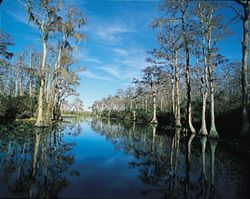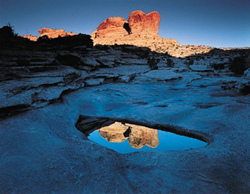
We have frittered away much in the last century. Open space from California to New York has been lost to suburban sprawl. Northwest wilderness has been gutted for timber. Aquifers and watersheds have been polluted, perhaps beyond restoration in our lifetimes. Preserving land for the future, forever, is critical.
 |
| Okefenokee Swamp, Georgia |
| Paul Rezendes
|
The best parts of CARA would add hundreds of thousands of acres to our state and national parks, build recreational facilities in cities, preserve historic sites, protect farm and ranch lands from development, and save wild places—like the ones shown on these pages. But as it stands now, CARA also includes some sections that could do real harm. It offers incentives for increasing offshore oil drilling. And it allocates some $780 million a year to coastal states, money that could be used for industrial buildup on the coasts, such as the roads, ports, bulkheads, and dredging projects needed to drill and transport oil.
 |
| Gold Bar, Utah |
| Tom Till
|
Fortunately, there is still time to change the bill. In May, CARA got through the House on a vote of 315 to 102. In July, the Senate Energy and Natural Resources Committee passed its own version by a vote of 13 to 7. Should Senate Majority Leader Trent Lott allow it on the Senate floor (and should the would-be filibusterers back off with their threats), the bill could be amended and could become law.
Take part in one of the most important environmental events in decades. As Amicus goes to press, the bill is not yet on the Senate floor. Write your senators and representative and tell them CARA money should not be used on projects that wreak havoc on the environment (see p. 46 for contact information). Tell them the incentives for offshore oil drilling must come out. Tell them you support a strong CARA that does what it should: create a permanent land preservation fund that will benefit generations to come.
—The Editors
Table of Contents | Email the editor | About Amicus/Subscribe | Search
The Amicus Journal. Fall 2000
Copyright 2000 by the Natural Resources Defense
Council